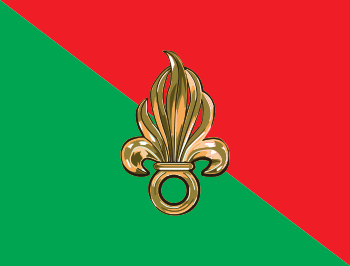1st Foreign Cavalry Regiment
| 1st Foreign Cavalry Regiment (1er Régiment Étranger de Cavalerie) | |
|---|---|
|
Regimental Insignia of 1er REC | |
| Active | 1921 – present |
| Country |
|
| Allegiance |
|
| Branch | French Army |
| Type | Armoured Cavalry |
| Role | Reconnaissance & fire support |
| Size | 900 men |
| Part of | 6th Light Armored Brigade |
| Garrison/HQ | Camp de Carpiagne (Bouches-du-Rhône), France |
| Nickname(s) | Royal Étranger |
| Motto(s) |
Nec pluribus impar |
| March | La Colonne (The Column) |
| Anniversaries | Camerone Day (30 April), Saint-Georges Day and Christmas |
| Engagements |
First Indochina War |
| Commanders | |
| Current commander | Colonel Valentin Seiler [1] |
| Insignia | |
| Insignia of the 1st Foreign Cavalry Regiment |
|
| Abbreviation | 1er REC |
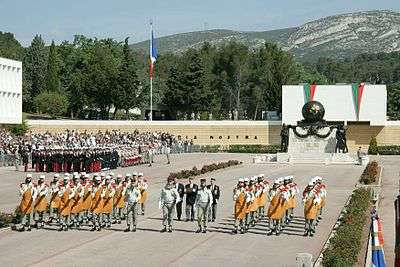
The 1st Foreign Cavalry Regiment (French: 1er Régiment Étranger de Cavalerie, 1er REC) is the only cavalry regiment in the French Foreign Legion. As of 2009 it was the only armoured cavalry regiment of the 6th Light Armoured Brigade.[2] The regiment recently moved camp after being stationed at Quartier Labouche for 47 years in Orange, Vaucluse, France since it moved from Mers-el-Kébir, Algeria in October 1967.[3]
History
Levant and Morocco since 1921
The 1st Foreign Cavalry Regiment (1er REC) was created on March 8, 1921 at Sousse following World War I from elements of the 2nd Foreign Infantry Regiment ( the naming of the 1er REC would not be official until January 20, 1922 following decree n°6330-1/11 of January 20, 1922).[4] The cadres of the new unit were drawn from existing French cavalry regiments. Only one junior officer (second lieutenant Antraygue) had previous Legion experience while one Non-commissioned officer had been in service with the 1st Foreign Regiment).
Of the 156 other ranks of the newly formed 1er REC, 128 were Russians. Thirty officers (one, a general and one, a colonel); 14 non-commissioned officers, 33 Cossacks and most of the remainder, cavalrymen.[4] Beginning in 1925, the 1er REC was engaged as mounted cavalry in Syria (4th Squadron ) and in Morocco (3rd Squadron). In both theatres of operations, the Foreign Cavalry Regiment served with distinction, notably in the Levant at Messifre (September 17, 1925) and at Rachaya (from November 20 to 24, 1925). The fanion of the 1er REC received the Croix de guerre des théâtres d'opérations extérieures with 2 palms, the fourragère of the colors of the Croix de Guerre and the 1st class Lebanese Order of Merit medal.[4]
From 1927 to 1934, the 1er REC saw active service in Morocco (the 3rd, 4th, 5th and 6th Squadrons), followed by patrol work along the northern border of the Sahara.[4] In 1934 the 5th squadron was equipped with White-Laffly and Panhard armored cars. The remainder of the regiment retained horses and sabers.
World War II and Indochina War
In 1939 the two existing regiments of Foreign Cavalry were still only partially motorized. However, in 1940, the 1e REC was dispatched to France as part of the 97th Reconnaissance Group of the Infantry Division (97e GRDI). As such it was engaged in combat from May 18 (at the Somme) until the Armistice.[4] A citation issued at the orders of the Armed Forces praised the heroism of the Legionnaires during this period.[4] Following the Battle of France the 1er REC took up garrison duties in Tunisia.[4] In 1943, the regiment was re-equipped with U.S. material, consisted of one light tank squadron and four armored car squadrons. Its new role was that of divisional recce regiment of the newly raised 5th Armored Division (5e DB).
In 1943, the 1er REC was engaged against the Germans in Tunisia.[4] In 1944, the 1er REC landed on the côtes de Provence as one of the French armored units participating in the Liberation of France.[4] At the end of World War II, the regimental colors were decorated with two new palms and the fourragère of the Croix de Guerre.[4] In 1946, the 1er REC embarked for Indochina.[4] The regimental squadrons plus two autonomes groups (detached units) served for nine years in Cochinchina and Tonkin.[4] Three new citations and the fourragère of the Croix de Guerre of TOE were added to the regimental colors, while the two autonomes groups earned 6 citations.[4]
Algeria and the modernization of the Regiment
After returning to French North Africa in 1954, the regiment was involved in the Pacification of Algeria for eight consecutive years of active service.[4] Following the Évian Accords and the independence of Algeria [4] the 1er REC regrouped at the base of Mers El Kebir. It was then reassigned, on October 17, 1967, to peacetime duty in metropolitan France for the first time.
The 1er REC was now based at Orange in the Quartier Labouche garrison.[4] Reattached to the 14th Infantry Division (14th DI) on January 1, 1976; the 1st Foreign Cavalry Regiment returned to Africa the same year, serving in Djibouti and then Mayotte.[4] In 1978 and 1979, the regiment participated in Opération Tacaud in Tchad where an Army citation was awarded.[4] During this period, the regiment received new equipment, including the FAMAS service rifle, MILAN anti-tank guided missiles, VAB armored personnel carriers, and the AMX-10RC armored car.[4] From May to October 1983, the 1st Foreign Cavalry Regiment served in three separate deployment areas: within the ranks of the Multinational Force in Lebanon; with a tactical command headquarters stationed in Beirut; in Tchad within the combat deployment cadre of Operation Manta; and in Djibouti.[4]
Within the ranks of the FAR and Division Daguet
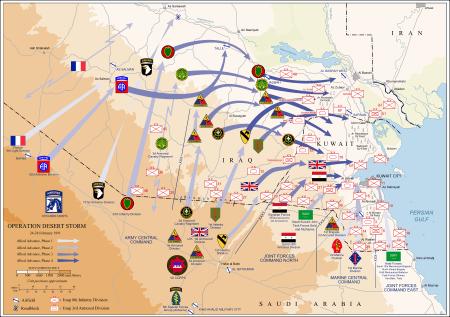
The 1st Foreign Cavalry Regiment remained within the Force d'action Rapide (FAR) and was part of the Division Daguet.[4] On July 1984, the Royal étranger was incorporated into the 6th Light Armoured Division (6e D.L.B).[4] Engaged in operation Daguet starting September 15, 1990; the regiment as whole was found complete in the desert of Saudi Arabia on November 6, 1990.[4] Following an initial preparatory phase, the regiment saw service as part of Operation Desert Storm.[4] On February 23, 1991; the regiment crossed the Iraqi frontier, reached its objective at the D'As Salman air base within 36 hours.[4] Victorious, the 1st Foreign Cavalry Regiment intact from personnel or material loss, decorated a new palm on the regimental colors.[4] From December 1992 to June 1993, the regiment served in Cambodia as part of the United Nations peacekeeping force (APRONUC).[4]
Operations post 1993
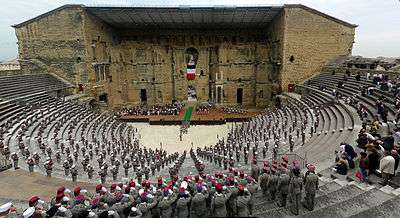
The 2nd Squadron of the Regiment served in Sarajevo as part of the United Nations Protection Force (FORPRONU) from October 1993 to February 1994, and subsequently with the cadre of BATINF from January to June 1995. From 1995 to 1996, the 1st Foreign Cavalry Regiment was engaged in the former Yugoslavia within the cadre of the force de réaction rapide (FRR) and in Chad as part of Opération Épervier. From May to September 1996, the 5th Squadron, recreated in July 1993, was first deployed in the Central Africa Republic during Operation Almandin II. The 1er REC also participated in Guyane, Mayotte and Djibouti. In 1997, the regiment served in the Republic of Congo assisting in the evacuation of refugees. During 1999 the regiment participated in operations with NATO forces in Kosovo, deploying one armored squadron (5e ESC) in the Macedonia, then dispatching the scouting squadron in Kosovo. Since then, the 1st Foreign Cavalry Regiment has participated in Operation Licorne in Kosovo and in Operation Pamir in Afghanistan
In January 2013, an AMX 10 RC unit from the regiment was deployed in Mali as part of Operation Serval, to counter an Islamist offensive against the local government and engaged in battle for control of the town of Diabaly.[5]
As of June 2015, with nearly 1,000 men and advanced equipment, the Regiment is on permanent stand-by to undertake any mission being allocated to.
Organization
The regiment is currently divided into 7 squadrons[6] with an estimated total manpower of 800 men.
- Escadron de Commandement et de Logistique (ECL) – Command and Logistics Squadron.
- 1er Escadron – 1st Squadron (4 combat troops and a command troop)
- 2e Escadron – 2nd Squadron (4 combat troops and a command troop)
- 3e Escadron – 3rd Squadron (4 combat troops and a command troop)
- 5e Escadron _ 5th Squadron ( 4 combat troops and a command troop)[7]
- Escadron d'éclairage et d'investigation de brigade (EEI) – Brigade Reconnaissance Squadron. (4 troops)
- Escadron d'Aide à l'Engagement (EAE) – anti-tank squadron
Equipment
Three squadrons are equipped with the AMX 10 RC, an armoured and wheeled vehicle with a 105mm gun.[2] The EEI is equipped with the Panhard VBL.[2]
Traditions
Insignias
-

Regimental Insignia of the 1st Foreign Cavalry Regiment, 1er REC
-

-
Insignia of the 1st Foreign Cavalry Regiment, 1er REC
-
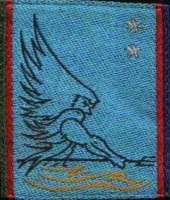
The Foreign Legion Groupment, G.L.E in the 31e Brigade featuring Poseidon
Regimental Colors
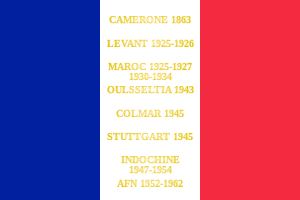
Decorations
- fourragère with ribbon colors of the croix de guerre 1914-1918 with olives of ribbon color of the croix de guerre 1939-1945
- fourragère with ribbon color of the Croix de guerre des Théâtres d'opérations extérieurs.[8]
- La Croix de guerre 1939-1945 with 3 palms.
- La Croix de guerre des théâtres d'opérations extérieures with 4 palms.
- La Croix de la Valeur militaire with 1 palm.
- 4th squadron decorated November 19, 2012 with Croix de la valeur militaire with palm ( Afghanistan )[9]
-

Croix de guerre 39-45 -

Croix de guerre des théâtres d'opérations extérieures
Honors
Battle Honors
- Camerone 1863
- Levant 1925–1926
- Morocco 1925–1927
- Ousseltia 1943
- Colmar 1945
- Stuttgart 1945
- First Indochina War 1947–1954
- AFN 1952–1962
- Koweït 1990-1991[10][11]
Regimental Commanders
|
Tenure (1921 - 1939)
|
Tenure (1935 - 1946)
|
Tenure (1948 - 1956)
|
|
Tenure (1955 - 1975)
|
Tenure (1955 - 1995)
|
Tenure (1995–present)
|
See also
Notes
- ↑ Official Website of the 1st Foreign Cavalry Regiment, Section Le Chef de Corps
- 1 2 3 "Le régiment". Retrieved 2011-12-30.
- ↑ Windrow, Martin (1996). French Foreign Legion Since 1945. p. 47.
- 1 2 3 4 5 6 7 8 9 10 11 12 13 14 15 16 17 18 19 20 21 22 23 24 25 26 27 Official Website of the 1st Foreign Cavalry Regiment, Section Historique 1er Régiment étranger de cavalerie
- ↑ Harding, Andrew. "Mali Conflict: 'French Fighting Islamists in Mali'". BBC News. Retrieved 16 January 2013.
- ↑ Insignias Heraldry of the 1st Foreign Cavalry Regiment
- ↑ "De nouvelles unités pour la Légion étrangère". Foreign Legion. Retrieved 2015-12-27.
- ↑ Par analogie avec les dispositions intervenues à l'occasion des hostilités qui se sont déroulées entre 1914 et 1918, il est décidé, en avril 1945, de commémorer par une fourragère les actions d'éclat ayant entrainé l'octroi d'au moins deux citations à l'ordre de l'armée aux régiments ou unités formant corps en opérations depuis le 2 septembre 1939. Il ne s'agit pas à proprement parler d'une fourragère nouvelle. En effet la forme et les couleurs de la fourragère 1914-1918 (Il n'existe pas de fourragère aux couleurs du ruban de la croix de guerre 1939-1945 actuellement, mais il y a eu une fourragère aux couleurs de cette dernière, mais qui a été abandonnée au début des années 1950, car elle apportait une certaine confusion, alors pour simplifier, le système des olives a été mis en place) sont maintenues mais il est créé un système d'olives qui placées au-dessus du ferret permettent de différencier l'origine de ces deux fourragères.
- ↑ article sur le site de la Légion étrangère
- ↑ Décision n°|12350/SGA/DPMA/SHD/DAT du 14 septembre 2007 relative aux inscriptions de noms de batailles sur les drapeaux et étendards des corps de troupe de l'armée de terre, du service de santé des armées et du service des essences des armées, fr:Bulletin officiel des armées, n°|27, 9 novembre 2007
- ↑ "Édition Chronologique n°|45 du 29 octobre 2010". Le Ministère de la Défense instruction n°|1515/DEF/EMA/OL/2 du 23 septembre 1983, modifiée, sur les filiations et l'héritage des traditions des unités; décision n°|010318 /DEF/CAB/SDBG/CPAG du 15 juillet 2008 portant création d'une commission des emblèmes. Art 1er. L'inscription "Koweït 1990-1991" est attribuée aux drapeaux et étendards des formations des armées énumérées ci-dessous. 2e R.E.I, 1er R.E.C, 6e R.E.G, 3e R.I.Ma, 1er R.P.I.Ma, 11e R.A.Ma, 4e Régiment de dragon, 1er Régiment de Spahis, 6e Régiment de Commandement et de Soutien, 1er R.H.C, 3e R.H.C, puis les formations de l'Armée de l'Air les 5e, 7e, 11e escadre de chasse, la 33e escadre de reconnaissance et les 61e et 64e escadre de transport. Le présent arrêté sera publié au Bulletin officiel des armées, Hervé Morin.
- ↑ Official Website of the 1st Foreign Cavalry Regiment. Section Ancien Chefs de Corps
References
- www.legion-etrangere.com
- Porch, Douglas (1991). The French Foreign Legion. New York: Harper Collins. ISBN 978-0-06-092308-2.
- Windrow, Martin (1996). French Foreign Legion 1914–1945. Oxford: Osprey Publishing. ISBN 1-85532-761-9.
- Windrow, Martin (1996). French Foreign Legion Since 1945. Oxford: Osprey Publishing. ISBN 1-85532-621-3.
External links
- Official site – 1er Régiment étranger de cavalerie
- History + images - 1er REC's History (English)
